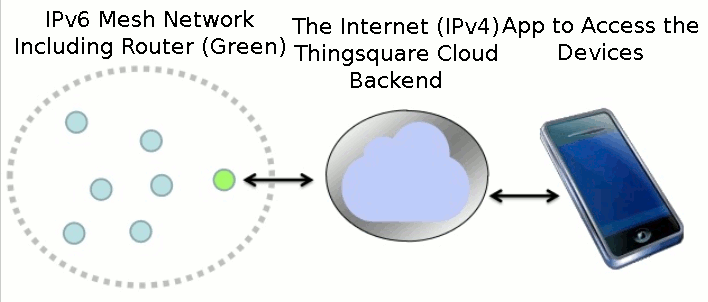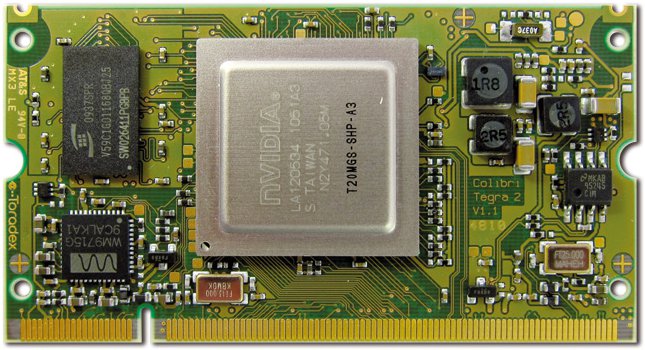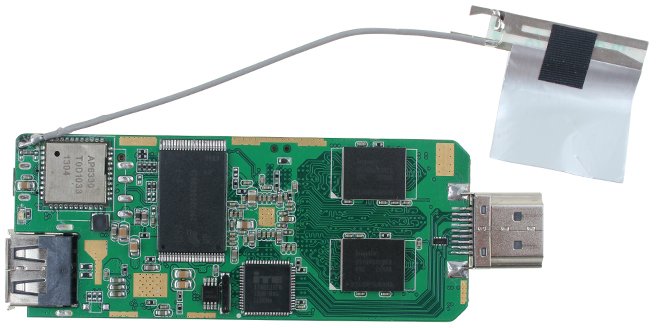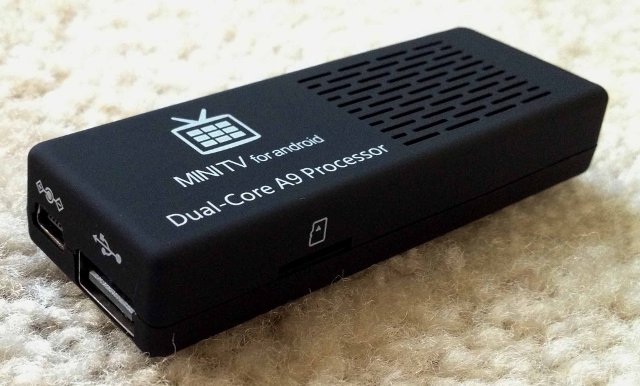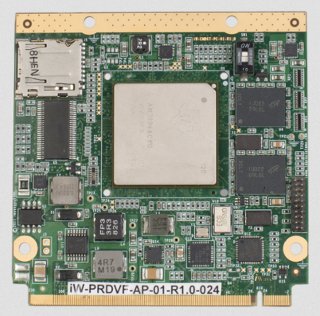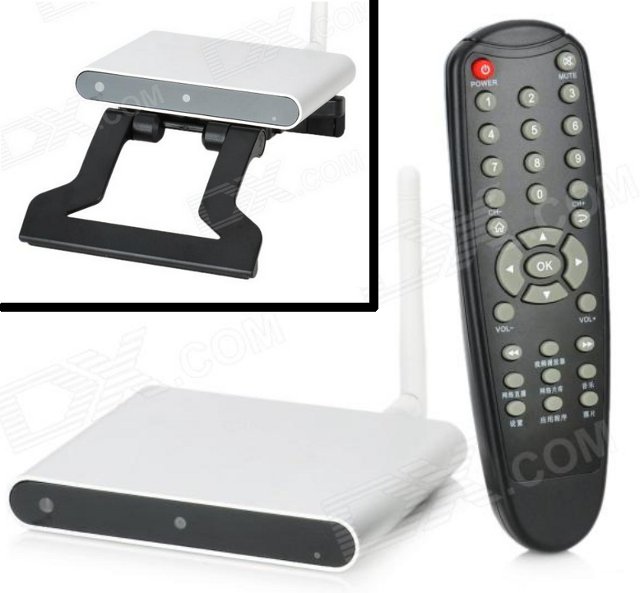RFDuino is a tiny board, about the size of a coin, powered by Nordic nRF51822 Cortex M0 SoC including bluetooth 4.0 LE support, and software compatible with Arduino UNO and DUE board, so you can just use Arduino sketches with the board. Bluetooth allows it to communicate with your smartphone (iPhone for now, but Android support is coming) to control motors & relays, monitor sensors, turn LEDs on/off, and more. Key features of RFDuino board: MCU – Nordic nRF51822 Cortex M0 @ 16 MHz Memory – 16 KB on-chip SRAM Storage – 256 KB on-chip Flash Connectivity – Bluetooth 4.0 Low Energy built in MCU GPIO – 7 pin software configurable as digital IO, analog ADC, SPI, I2C, UART and PWM. The company currently offers several stackable shields for RFDuino including battery shields (1x AAA, 2x AAA, and CR2032 coin battery), a servo shield, a USB shield, a prototype shield […]
Thingsquare Mist – Open Source Firmware for The Internet of Things
Thingsquare recently released the source code for the Thingsquare Mist firmware, an ultra lightweight router software (<4 kB memory) for the Internet of Things based on open Internet standards such as IPv6, RPL (Routing Protocol for Lossy networks), and 6lowpan. Thingsquare Mist allows to connect battery-powered wireless micro-controllers to the Internet, and is currently used in applications such as smart light bulbs, connected home appliances, and connected cities. The IPv6 mesh network is composted of nodes with a low power radio that communicate with the Mist router (Green), which in turn connect to the Internet and Thingsquare Cloud backend (Thingsquare Haven) to store the data, and/or receive control commands via Ethernet or Wi-Fi. The end users can then use an App to monitor, and/or control the devices remotely. Thingsquare Mist uses IETF RPL IPv6 mesh routing protocol (pronounced “ripple”) for IPv6 nodes communications. Thingsquare Mist runs on several low-power wireless […]
Embedded Android Training Workshop At Linaro Connect Asia 2013
Karim Yaghmour, Opersys’ CEO, gave 4 training sessions dealing Embedded Android at Linaro Connect Asia 2013, in Hong Kong, earlier this month. Charbax filmed those 4 40 to 50 minutes session with excellent video and audio quality, so I encourage you to watch all sessions if you are interested in this topic. The presentation slides are available on Slideshare. The first training session is entitled “Android Internals”, and Karim introduces Android’s overall architecture, following the agenda below: Android Concepts Framework Intro Overall Architecture System startup Linux Kernel Hardware Support Native User-Space Dalvik JNI System Server Calling on Services Activity Manager Binder HAL Stock AOSP Apps Case-in-Point The second session “Working with the AOSP” deals with the following key points: Tools and location Content Building Build tricks Build system architecture Output images Using adb Custom toolchains and dev kits Compatibility Test Suite Basic hacks The third session entitled “Native Android user-space” […]
Are You a Student? You Could Win a Toradex Colibri NVIDIA Tegra Kit and Up to $20,000
Toradex has launched the “Embedded Design Challenge”, a global design challenge for students and enthusiasts with a background in Research & Education. All you have to do is to submit your proposal, and if it is selected you’ll receive a free Toradex Colibri NVIDIA Tegra Kit (worth 250 USD) to realize your project. Toradex did not mention whether the kit is based on their Tegra 2 or Tegra 3 modules, but I assume they’ll provide “Toradex Colibri NVIDIA Tegra Kit” composed of Colibri T20 CoM (Tegra 2 + 256 or 512 MB RAM+ 512 MB / 1 GB Flash) and the Iris carrier board. This kit can run either Windows Embedded Compact 7 or Linux. You can find more information about the kit and associated resources on a previous post. To apply, you’ll need a resume (PDF), a proof of your enrollment with an educational institution (e.g. copy of your […]
How to Root Rockchip RK3188 mini PCs
CloudnetGo CR9 was the first Rockchip RK3188 mini PC I had ever seen reported, but since then others apparently based on the same board have started to show up including Tronsmart T428, Rikomagic MK802 IV, as well as Ugoos UG802B, UG007B and MK809 III. We’ll get a lot of choices, but most of time the firmware does not provide root access. I noticed AndroidPC.es published instructions to root those device in Spanish yesterday, but today, Geekbuying rooted the Ugoos devices with the same method used for RK3188 Tablets. You have to follow those 5 simple steps: Make sure USB Debugging is enabled on your mini PC (Settings -> Developer Options) Connect your RK3188 mini PC to a Windows PC via the USB port. Your PC should detect a new device, and try to install the driver. You can download the driver at https://www.dropbox.com/s/uqisjj4hqftlaxa/GEEKBUYING_Rockchip_Batch_Tool_v1.6.rar (password: GEEKBUYING.COM) After having installed the driver, download […]
MK808 mini PC gets Android 4.2.2 Beta Firmware
Last week, Geekbuying announced the first release of Android 4.2.2 for MK808, with support for MK808B coming soon. They warn users that it’s still beta since this is the first time Android 4.2 is available on Rockchip RK3066 mini PC, however I could not find user’s complains in the comments section, but at least one users in ARMTvTech is disappointed by this release. You’ll find three download links: Android 4.2.2 for MK808 (dropbox) – Currently unavailable due to heavy traffic Android 4.2.2 for MK808 rooted (Gdrive) – Same version as above but rooted by deadhp1 RKBatchTool 1.5 (dropbox)- Windows tool to perform the upgrade. Currently unavailable but there are alternate links. Once you get the files, you can follow the instructions showing how to upgrade MK808 firmware, or watch the video showing the upgrade process. MK808 is another device I don’t own, so I haven’t been able to try it […]
iWave Systems Launches RainboW-G12M-Q7 SoMs Powered by TI Sitara AM389x/DM816x Processor
iWave Systems, an embedded systems company based in Bangalore, India, has unveiled new Qseven Modules powered by Texas Instruments Sitara AM389x/DM816x ARM Cortex-A8 microprocessor clocked up to 1.5 GHz. Rainbow-G12M-Q7 modules target applications such as Single-Board computers, network and communication processing, industrial automation, human machine interface (HMI), medical electronic devices, video surveillance systems and interactive Point-of-Service (PoS) kiosks. Here are the modules specifications: CPU – TI AM389x/DM8168 ARM Cortex-A8 based Sitara Processor operating up to 1.5 GHz Memory: 1GB DDR3 SDRAM 128 MB NAND Flash On-Board Micro SD slot 230-pin Qseven Edge Connector: 1x PCIe v2.0 1x HDMI 1.3 2x SATA LVDS channel 1 x USB 2.0 Host | 1x USB 2.0 device I2S Port SD/SDIO SPI & I2C ports Expansion Connector: Gigabit Ethernet HD Video IN/OUT Ports Analog Video OUT Audio IN/OUT ports UART, GPIOs Form factor – Qseven R1.20 compatible (70mm x 70mm) Temperature Range – 0 to […]
$86.50 TVi7 Android TV Box Powered by Rockchip RK3066
Yesterday, Technici left a comment about a Rockchip RK3066 set-top box sold on a Polish website. The device is called “SMART MEDIA BOX TVi7” is the brochure in Polish, so I went on a search and found in DealExtreme for $86.50. Since I previously reported about the Wise TV Box also based on RK3066 but selling for $59.99, so I was about to pass on this one, until I found out Wise TV Box now costs $97, which makes this new device potentially interesting. TVi7 specifications: SoC – Rockchip RK3066 @ 252MHz~1608MHz + Mali 400 MP4 GPU System Memory – 1GB DDR3 Storage – 8GB NAND Flash + micro SD slot (up to 32 GB) Connectivity Wi-Fi – 802.11 b/g/n Ethernet – 10/100 Mbps (RJ45) 3G – Via external USB Dongle Video Output – HDMI 1.4 (1080p) Video Codecs – H.264, VP8, RV, WMV, AVS, H.263, MPEG4 Audio Formats – […]



